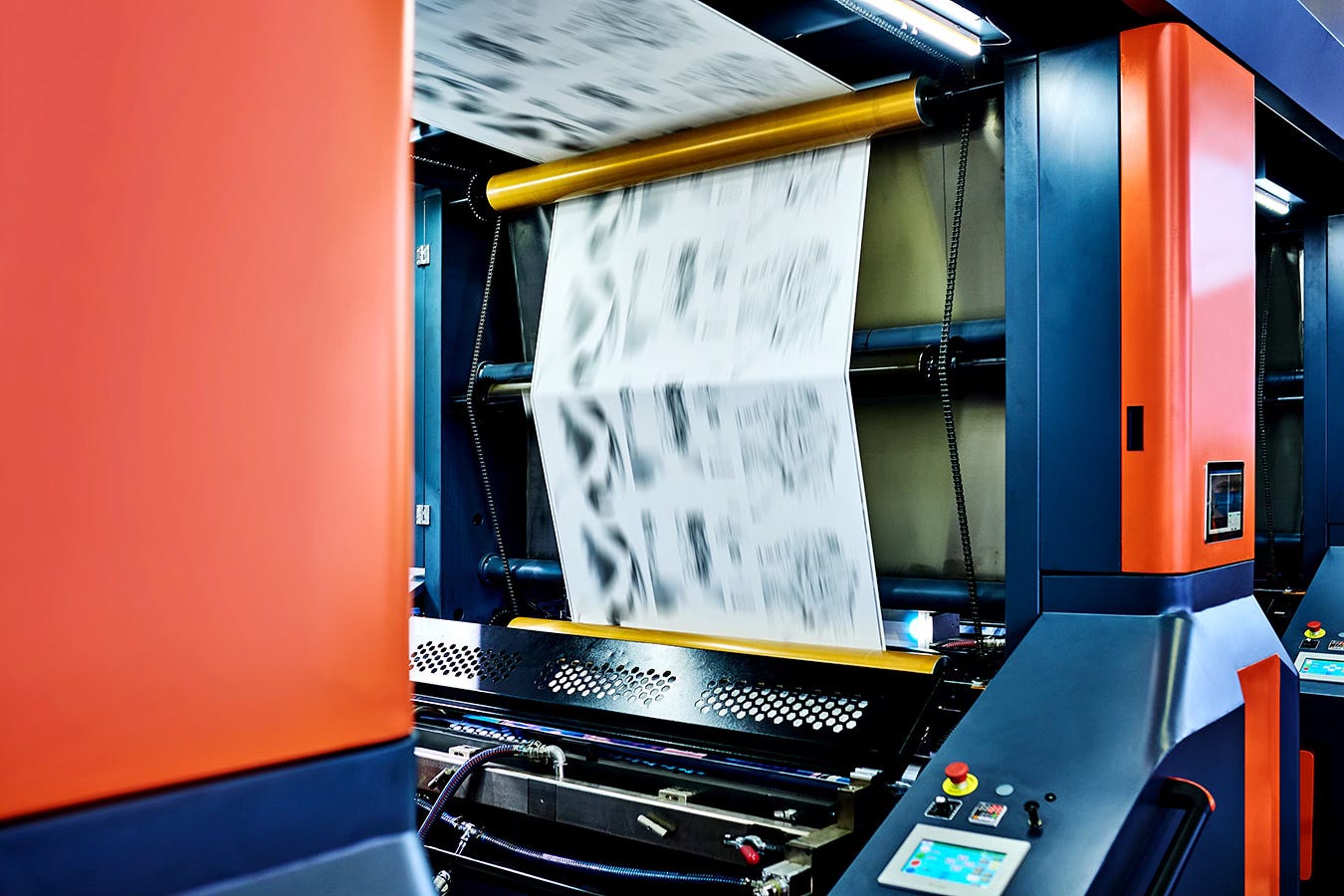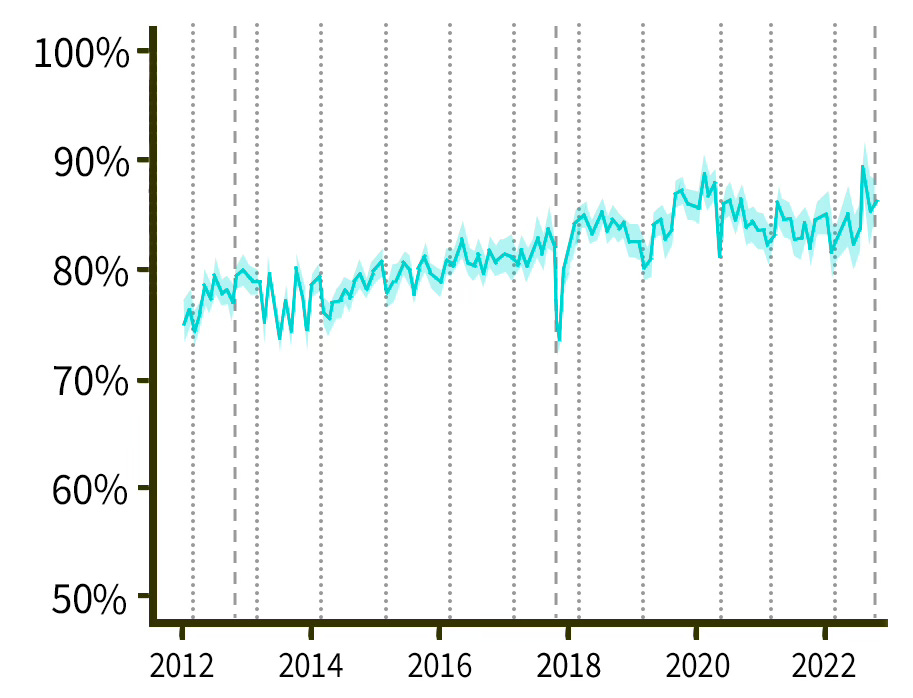Speaking with One Voice: The Growth of CCP-authored News Media in China
How common is government-scripted propaganda in China’s commercialized but Party-controlled press?
INSIGHTS
Analysis of 11 million articles in 700 Party and commercial newspapers from 2012 to 2022 finds that “scripted propaganda” — articles sourced directly from state news media like Xinhua — has grown from 6% to 8% of articles in Party papers and 4% to 6% of articles in commercial papers.
Scripted propaganda appears in 80% of Party newspapers almost daily and exceeds 50% of articles during sensitive political events.
About 10% of homepage articles on popular news portal Sina.com (2012–2019) were scripted (two to three scripted homepage articles daily).
Over 60% of scripted propaganda focuses on nationalism and politics, but it also covers crime and crises (20%), and seemingly neutral livelihood issues (4%).
Scripted propaganda on the front page rose from 7% to 20% (2012–2021), with scripts increasingly reprinted verbatim.
These findings reflect tighter central control and growing uniformity in state messaging.
Source Publication: Hannah Waight, Yin Yuan, Margaret E. Roberts, and Brandon M. Stewart (2025). The decade-long growth of government-authored news media in China under Xi Jinping. Proceedings of the National Academy of Sciences.
China has one of the most sophisticated and well-studied systems of media control. After 1980, the CCP began commercializing the press, and by the late 1980s through the 2000s, investigative journalism became more common, with media sometimes permitted to report on local corruption and negligence. Many observers saw this process as a gradual loosening of control. But since Xi Jinping took power in 2012, media freedom has contracted, with crackdowns on journalists, platforms, and internet users to shape public perception of the government. In this mixed landscape of commercialization and centralized Party control, how widespread is centrally scripted propaganda in China’s newspapers?
The data. The researchers draw on a dataset of over 11 million newspaper articles from 46 local Party and commercial newspapers in China, spanning 2012 to 2022, supplemented by a broader set of over 700 newspapers used in case studies of crises like COVID-19 and earthquakes. Using a corpus of over 1,000 leaked propaganda directives obtained from China Digital Times, the researchers link scripts written by China’s central government to newspaper articles and detect patterns of coordinated publication.
Propaganda, not syndication.“Scripted propaganda” refers to articles that are sourced from government-run news like Xinhua News Agency and mandated for publication across multiple newspapers, typically through the Publicity Department, a central Party organ under the CCP Central Committee that is responsible for ideological control, media oversight, and information dissemination. These articles are not original reporting by the newspapers themselves, but rather coordinated content that appears in multiple outlets on the same day, often sharing large portions of identical or near-identical text. The researchers distinguish scripted propaganda from syndicated articles by tracking same-day clusters of similar articles across 10 or more (out of 46) newspapers. Common syndicated content like weather or soccer rarely appears in such large clusters. The researchers validate this pattern against leaked propaganda directives. This approach lets them isolate scripting as centrally mandated, not a voluntary editorial choice.
Share of articles on front page that are scripted propaganda
Scripted propaganda crowding out journalism, even in commercial media. Between 2012 and 2022, researchers found that scripted propaganda in Party newspapers rose from 6.1% to 7.8% — a 28% increase — as total article volume declined. Scripting spiked on sensitive political days, reaching over 50%, especially during the Two Sessions and five-year Party Congresses. Commercial papers showed slightly lower scripting rates (rising from 2% to 4%) but experienced similar surges above 30% on key dates. On Sina.com (2012–2019), a popular online news portal, about 10% of headline articles were scripted, averaging two to three scripted stories in the news headline section of the homepage. Front-page scripting in Party papers also rose sharply, from 6.7% in 2012 to 20.3% in 2021, with newspapers increasingly reprinting scripts verbatim, signaling tighter control and growing uniformity in messaging.
While increasingly focused on ideology, scripted propaganda spans many topic areas. Researchers categorized articles into 17 themes and found that scripted content is most prevalent in diplomacy (40.6%), nationalism and values (22.0%), national politics and ideology (19.9%), and international affairs (18.6%). Scripted articles also appear in areas like crises (9.8%), law and crime (9.8%), and livelihood issues (4.1%). Even seemingly apolitical stories are scripted. For example, an article on heavy rainfall and disaster response in May 2012, though factual in tone, was identified as scripted. Within generally low-scripted categories (e.g., local sporting event outcomes), certain subtopics, like Olympics coverage or personal stories linked to national policy, are frequently scripted. Commercial papers follow similar patterns on sensitive topics, but target less-scripted topic areas such as business (0.8%), culture (1.1%), and lifestyle (0.7%).
Percent of sentences per scripted article that are copied nearly verbatim
A COVID case study. Through analysis of 1.07 million articles from 708 newspapers between December 30, 2019, and May 1, 2020, researchers found that before Wuhan’s lockdown on January 23, fewer than 50 COVID-related articles appeared daily — nearly all scripted. Coverage surged to 1,250 articles on January 21, then stabilized at 10,000–15,000 per day post-lockdown, with scripting remaining steady. Despite rising public interest (evident in Baidu search trends), independent reporting lagged. Scripted content extended beyond ideology to include case counts, treatments, unemployment, and aid, illustrating how propaganda shaped both narrative and facts during the crisis.
Fewer voices. From 2012 to 2022, over 80% of Party newspapers published centrally scripted articles on nine out of 10 days. On sensitive topics like national politics, during events such as Party meetings, or at the onset of crises like COVID-19, scripted content made up one-third to one-half of newspaper information. These findings suggest that the prevalence of propaganda significantly limits the diversity and depth of information available to the public, increasingly crowding out independent reporting and narrowing the range of perspectives in news coverage.





